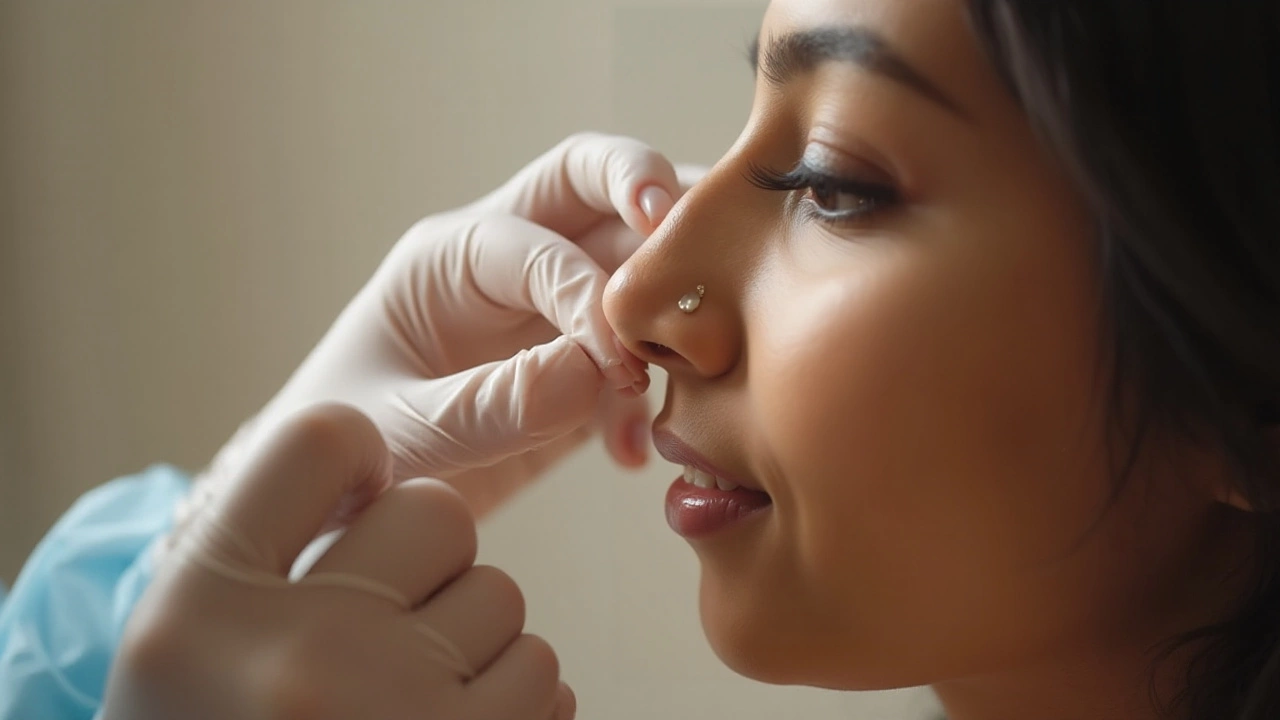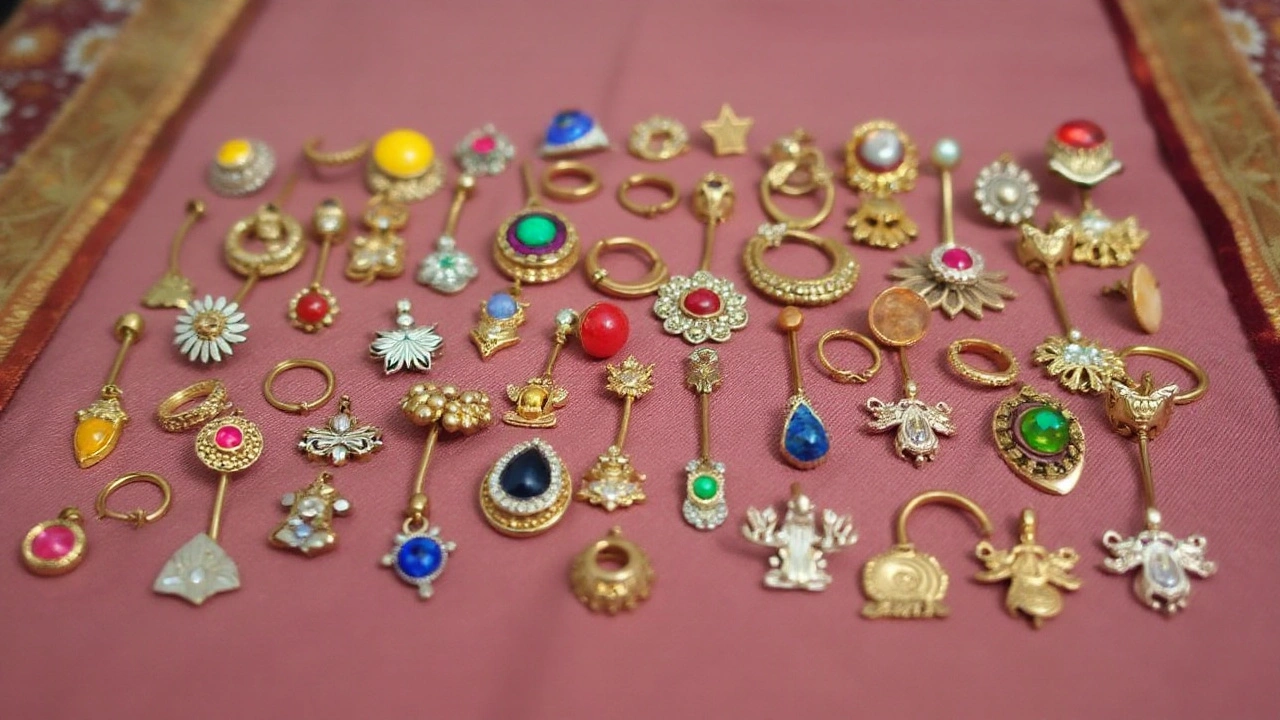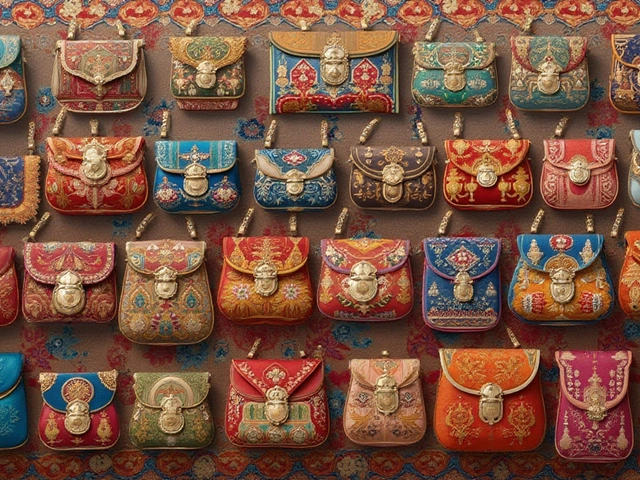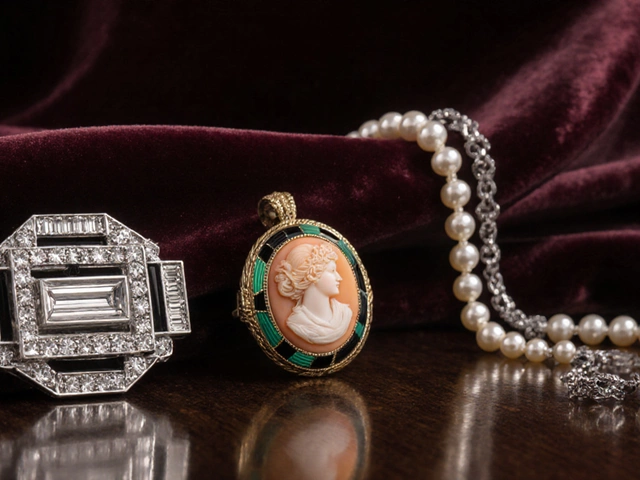
Nose piercings have become a canvas for personal expression, but switching immediately to a nose ring isn't advisable. The initial jewelry choice, usually a stud, plays a vital role in the healing journey. Though it's tempting to show off a shiny ring right away, patience and care are more beneficial for your new piercing.
Understanding the healing process is the first step in ensuring the healthy adoption of a nose ring. When you puncture your skin, your body needs time to adjust and start repairing itself. This period requires a delicate balance of hygiene and adequate jewelry that supports rather than hinders healing.
With proper attention, you can avoid complications and explore a world of nose pin designs tailored to your style. The variety of options allows for endless customization, ensuring that when the time is right, your nose ring can reflect your unique personality.
- The Initial Healing Process
- Why Choose a Stud First
- Potential Risks of Early Ring Insertion
- Hygiene and Care Tips
- Exploring Nose Pin Designs
- Customizing Your Look
The Initial Healing Process
When it comes to getting a nose ring, understanding the initial healing process can help set realistic expectations and prevent potential complications. Right after the piercing is done, the body kicks off its natural response to what it perceives as an injury. This reaction starts with inflammation, a necessary step that clears out bacteria and prepares the tissues for repair. During this period, the area will be tender and possibly swollen, which is completely normal.
The body’s repair mechanism kicks in by forming what is called granulation tissue. Over time, this tissue hardens into a tunnel called a 'fistula' around the piercing. This process can take several weeks or even months, depending on individual healing speeds and how well the wound is cared for. It's crucial not to disturb this developing fistula by switching to a nose ring too soon, as doing so can lead to irritation, infection, or even a closed piercing. It's much like planting a garden—care and time are needed before you can expect it to flourish.
One might wonder how long the healing process actually takes. In most cases, a nose piercing can take anywhere from two to four months to sufficiently heal, although some people might require a longer recovery period. Factors affecting healing time include the individual's health and how rigorously they follow aftercare instructions. Ensuring cleanliness and avoiding unnecessary contact with the piercing are vital steps in this aspect.
According to the Association of Professional Piercers, swapping jewelry too early is one of the main causes of piercing complications. They recommend adhering to professional advice about suitable healing times before switching styles.
It's also worth understanding the role of initial jewelry choice in this healing stage. A surgical-grade stainless steel or titanium stud is usually recommended initially because it's hypoallergenic and suitable for sensitive skin. The shape of a stud offers stability while the area heals, minimizing the movement that could exacerbate healing tissues. Be wise about picking the right starter to set the stage for healthy healing.
While healing, some may experience the occasional itch or redness, which is par for the course. However, severe pain or discharge is a red flag, often signaling an infection or allergic reaction. In such events, consulting a medical professional promptly is necessary to address any underlying issues effectively.
Why Choose a Stud First
Choosing a stud initially for your nose piercing is pivotal, acting as a safeguard as your body begins its natural healing process. The role of the initial stud is often underestimated, yet it is designed specifically to support your skin as it begins to close up around this newfound addition. A stud provides stability that a more movable nose ring might lack, minimizing the risk of irritation. Initial studs, typically crafted from skin-friendly materials such as titanium or surgical stainless steel, are less likely to cause allergic reactions, which is crucial given the sensitivity of freshly pierced skin.
The initial period following a nose piercing is known to be the most critical, lasting anywhere from four to six months depending on individual skin types and care. A stud lessens the chances of the surrounding skin tearing or becoming inflamed, which a tightly fitted or heavier jewelry piece like a ring could inadvertently cause. This selection of jewelry doesn't just assist in shielding the piercing from unwanted tugging—you won't face issues related to movement that can occur with a larger nose ring.
A good deal of advice stems from the experiences of respected professionals in the industry.
"Starting with a stud gives the skin just the right support without overwhelming it. Keeping it simple at the start paves the way for better results later," explains Linda Hollins, an acclaimed piercer with over a decade's experience guiding nose piercing enthusiasts on their journeys.This approach also makes daily cleaning—a non-negotiable in the piercing's early days—significantly more straightforward. A stud holds its place solidly, making it easier to sterilize the area, reducing infection risk.
Moreover, remember that many studios require an initial stud for piercings. This practice isn't just tradition—it's a well-calculated step based on years of studied observation. In rare instances, when a piercing shows signs of slower healing or if it experiences external irritation, switching to a smaller, refined stud can often help alleviate pressure and speed up the recovery, buying some essential time before a coveted nose ring can safely take its place. Patience here cannot be understated; adopting a stud first might seem modest, but it's a strategy laden with wisdom for a lasting piercing.

Potential Risks of Early Ring Insertion
Switching from a stud to a nose ring too soon after a piercing presents several risks that can lead to prolonged healing times or even permanent complications. For starters, the fresh piercing is still an open wound, requiring time to form a healing layer that protects against infections. Inserting a ring prematurely can easily introduce bacteria or irritate the healing tissue, creating a perfect storm for infections.
Moreover, rings necessitate extra rotations and movements, which can disturb the piercing site. This involuntary motion can cause what's known in the piercing world as "piercing rejection," a process where the body begins to push out the foreign object. The effect can create unsightly scars, known as keloids, or worse, leave your skin permanently damaged. "Patience is key," advises Dr. Jane Collins, a renowned dermatologist, in an interview. "Allowing your body to acclimate minimizes the risk of unwanted physical responses," she adds.
Another risk lies in the discomfort and potential pain caused by swelling. New piercings tend to swell slightly, and a ring, due to its shape, offers less flexibility than a stud. Rings can pull against your skin, exacerbating the swelling or potentially causing a tear in the piercing channel. In a worst-case scenario, it could close altogether, resulting in the need to re-pierce.
A table illustrating common side effects associated with premature ring insertion could be immensely beneficial. Consider a case where 45% of early ring insertions led to minor infections, while 25% resulted in noticeable scarring. Interestingly, 30% reported increased healing times compared to those who stuck with a stud initially.
| Side Effect | Percentage Affected |
|---|---|
| Minor Infections | 45% |
| Noticeable Scarring | 25% |
| Increased Healing Time | 30% |
Additionally, incorporating elements like a slight curve in the hook of a stud allows room for movements without harming the piercing site. This accommodation is crucial for environments where accidental bumps can happen, such as bustling public spaces or even peaceful bedroom settings. An early switch to a ring, with its looped design, wraps tightly around the nose, lacking the flexibility needed during this delicate healing phase.
Making an early switch to a nose ring often arises from excitement or impatience. However, informed decisions based on awareness of these risks can lead to a healthier, smoother journey in body ornamentation. Taking the time to remain cautious with your piercing not only ensures that it will heal properly but paves the way for a beautifully personalized expression of style in the long run without unnecessary hurdles.
Hygiene and Care Tips
Taking care of a new nose piercing demands vigilance and a proper hygiene routine, essential not only for the health of your piercing but also for the future of your desired nose ring. New piercings are essentially healing wounds, requiring care to minimize infections and other complications. Start your routine by cleaning the pierced area twice a day with a saline solution, which is ideal because it is gentle yet effective. Avoid using alcohol or hydrogen peroxide, as these could excessively dry out or irritate the healing skin. Letting the natural healing process take its course without interference can often be the best approach.
It's crucial to avoid touching your nose ring with unwashed hands, as bacteria and oils can easily transfer and lead to infections. If an itch occurs around the piercing site, which is common during the initial stages of healing, resist the urge to scratch or twist the jewelry. Consistent movement of the initial stud can interfere with healing, causing irritation or even slight tearing. Some piercers recommend rotating the stud gently while cleaning, but guidance on this method is varied among professionals. "A piercing is a minor surgical procedure, and respecting the body's healing timeline is vital," notes renowned piercer Jef Saunders.
To further ensure proper healing, refrain from applying any creams or ointments unless expressly advised by your piercer, as these can trap bacteria and prevent the area from breathing properly. Additionally, care should be taken while sleeping, ensuring that your face does not press into the pillow in such a way that it stresses the piercing. Switching pillowcases frequently is an easy step to further protect your healing nose. Bear in mind the importance of avoiding submersion in public pools, hot tubs, or bathtubs during the early stages, as these environments can introduce various germs to the healing site, potentially halting progress.
Diet also plays a role in ensuring the smooth recovery of your piercing. Staying hydrated aids cell regeneration, while a balanced diet rich in vitamins and minerals supports your body's natural healing immune system. Keeping the wrong foods at bay, such as excessive sugar or caffeine, can positively impact how quickly and problem-free your nose heals. Certain deficiencies, particularly in nutrients like zinc or vitamin C, could slow the healing process. Another factor to consider is how your lifestyle might affect your new piercing: high-stress levels and lack of adequate sleep could undermine the body’s ability to repair effectively.
Lastly, for those who might be more prone to allergies or sensitivities, it is imperative to choose the right material for body jewelry. Common safe materials include surgical steel, titanium, and 14k gold, which are less likely to provoke an allergic reaction. If you notice any unusual swelling, persistent redness, or discharge, those are signs that the healing isn't proceeding optimally, and it might be wise to seek a professional opinion. Empower yourself with these piercing care tips and make transitioning to your ideal jewelry design a safe and joyful experience.

Exploring Nose Pin Designs
Delving into the world of nose pin designs unveils a treasure trove of cultural significance and personal flair. Different regions and traditions bring their own nuances to these designs, creating a rich tapestry of art that can adorn your nose. For instance, in India, the 'nath' is more than mere ornamentation; it denotes marital status and is often an ornate piece worn during special occasions. Its elaborate design, sometimes extending across the cheek, is indicative of deep-rooted customs, evolving today to take on bold and fashionable expressions in contemporary urban settings.
There is a wide variety of materials used in creating nose rings and pins, each lending its unique traits to the jewelry. Traditional choices such as gold and silver remain wildly popular because of their hypoallergenic properties and timeless appeal. However, modern demands have led to the inclusion of platinum, titanium, and rose gold in the mix. These materials not only offer durability but also introduce a new array of aesthetic possibilities. According to Elle Magazine, choosing the right material isn't just about fashion but also about ensuring skin compatibility and minimizing any risk of allergic reactions.
Nose pins come in an array of shapes and sizes, each catering to a distinct preference or cultural symbolism. A simple stud, often the starter for newly pierced noses, sets the stage, allowing for simplicity and sleekness that complement everyday fashion. As you venture beyond the modest stud, consider the more expressive hoops or the intricate floral designs which, as Vogue once noted, "offer a mini art gallery for your face." Such designs enable individuals not just to wear a part of their heritage but to craft a global statement of style.
As seen in a feature by Harper's Bazaar, "Choosing the right nose pin is about striking a harmonious balance between comfort and statement."
For those seeking something less conventional, playful designs such as hearts, stars, or even minimalistic bars provide alternative expressions of creativity and personalization. They break away from tradition, offering you a chance to redefine what nose jewelry means to you. Notably, there has been a surge in diamond-accented nose pins, straddling a fine line between elegance and unspoken luxury, which have found favor among celebrities and trendsetters alike.
Ultimately, selecting a nose ring or pin is a deeply personal choice. It is an extension of one's identity, a reflection that nuances beauty standards across cultures and time. As you embark on this journey of discovering the perfect piece, consider what the design says about you and let it speak volumes of your style and story.
Customizing Your Look
Once your piercing has healed, the fun part begins—the freedom to choose a nose ring that perfectly complements your style. This is an opportunity to make a personal statement, to let your jewelry design echo your personality. From dainty, understated pins to bold, elaborate designs, the selection is vast. Among the popular choices are simple hoops, which can suit both a casual day out and a glamorous evening; studded rings sparkling with gemstones offer a touch of elegance, while playful designs in whimsical shapes appeal to the more adventurous spirit.
When opting to customize your look, consider the material of your nose pin. It’s crucial for health and style that you select high-quality materials, such as surgical-grade stainless steel, titanium, or gold, which are less likely to provoke allergic reactions. These materials not only offer safety and comfort but also let you wear your art confidently. Don't forget the option for custom engravings or personalized initials, which can make your piece unique. An emerging trend involves designs inspired by cultural motifs, allowing you to embrace and showcase a part of your heritage.
Choosing the right size and fit is another essential aspect of customization. It might require some trial and error, but once you find a fit that complements your facial features, it will highlight your uniqueness. It's beneficial to consult with a professional piercer who can offer insights on styles that suit your nose shape and size. The right fit ensures comfort, allowing you to wear your chosen nose ring daily without discomfort or irritation. The joy of discovering new piercing care techniques can also lead to a lifelong appreciation of how to maintain and display your nose jewelry at its best.
For those who love to stay on top of fashion trends, keeping abreast with seasonal changes in nose pin styles is key. Trend analysts predict that minimalistic styles will remain prominent, along with vintage-inspired pieces making a significant comeback. You could experiment with mixed metals or integrate small charms to create layers of interest. In the words of jewelry expert Mia Green, "Your nose ring is not just an accessory, but an extension of your innermost self, a statement that is uniquely yours."
Whether you aim for a subtle look or wish to showcase something extravagant, customizing your look is all about individual expression. A collection of rings can transform your mood and appearance daily. With thoughtful selection, you can harmonize your pieces with clothing and other accessories, crafting a cohesive aesthetic. Remember, your nose ring is more than a fashion item; it's a testament to your creativity and individuality.








